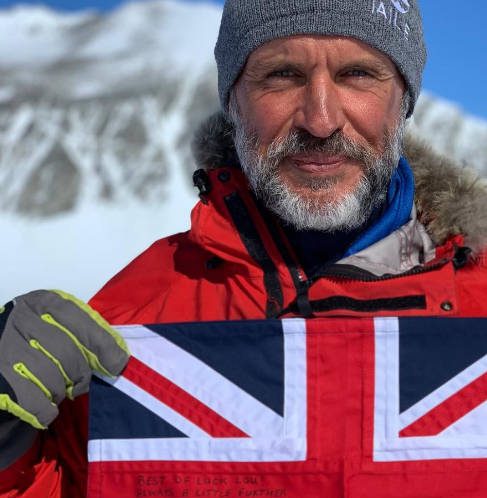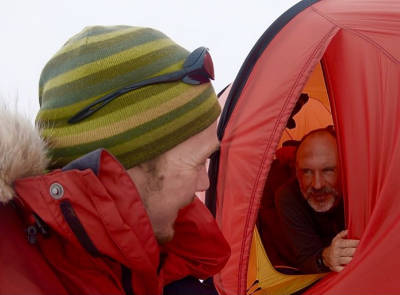We never show up before the second inning!

01/06/2019

When it comes to polar exploration, history is the mother of all excursion. To close out 2018, Louis Rudd became the second person to complete a solo crossing of the continent of Antarctica. In what seems a repeat of the Shackleton/Amundsen race to the pole (that was a race to the pole and not a traversal of the continent), the British-born Rudd finished on December 28, 2018, just two days behind American Colin O’Brady, but unlike Shackleton’s loss to Amundsen to the pole, it wasn’t really a race per se, and of course nobody died.
It cannot be overstated how difficult it is to ski from one Antarctic coast over the south pole to the opposite Antarctic coast. The two men traveled more than 900 miles over one of the world’s harshest environments, each pulling their supplies on a sled behind them as they skied over the surface. No Skidoos. No dogsleds. No vehicles. No airdrops or resupply. No kites. No food caching. No help whatsoever. Just two men, each alone, each moving under his own power, each pulling sleds that weighed over 300 lbs. Much of that weight was food to keep up their 10,000 calorie daily intake just to keep going — and they each STILL managed to lose a significant amount of weight. They faced temperatures of -30°F (-34°C) with -80°F wind chills (-62°C), snow blindness from the intense sun and white surfaces, not to mention uneven terrain with deep fissures into which a person could disappear, possible starvation, very possible dehydration due to the extremely dry air, and altitude sickness since much of their trek traversed an ice plateau at 9,000 ft in altitude (2,743 m) made worse by the thinner than usual atmosphere at the pole due the centrifugal action of the Earth’s rotation, which causes the altitude to feel more like 14,000 ft (4,267 m). All in all, it’s difficult as hell and very easy to die.
O’Brady and Rudd set out on November 3, 2018, from locations about a mile apart on the Ronne Ice Shelf. O’Brady technically had a 10-minute head-start, but over that distance it didn’t really constitute a “head start”. Either way, it wasn’t a deciding factor.
Rudd pushed hard on the first day and jumped to an early lead covering more ground. Things got a little gnarly for the two when the winds picked up causing nearly whiteout conditions. By day 7, O’Brady took the lead and stayed in front for the rest of the race. He reached the South Pole on day 40, and Rudd did so the next day.
The going toward the pole was rougher than expected. It had been a more snowy than usual summer season, which means that the normally hard and icy surface was covered with some fresh powdery snow, which made pulling their sleds much more difficult.
O’Brady finished his trek in 53 days, and covered a total of 932 miles (taking into account detours he had to take because of the difficult terrain in places). The last 77.5 miles of the journey, O’Brady covered in one last 32-hour straight trek. He finished at the foot of Leverett Glacier on the Ross Ice Shelf, and then set up camp.

Colin O’Brady (left) greets Louis Rudd (right) in Antarctica after their historic treks.
A little over 48 hours later, on day 56, Rudd came upon O’Brady’s tent — the first sign of another human he had seen since he began his trip — thus becoming the second person to do a solo trek across Antarctica via the South Pole.
Rudd had already gotten word of O’Brady’s finish via phone, so he wasn’t completely surprised to see the tent there. But what was somewhat alarming for the tired, emaciated, and cold second finisher was that when he went over to the tent to say hello to O’Brady, Rudd found that there was nobody inside!
Now Rudd was a Royal Marine and a very experienced Antarctic trekker (he had previously crossed the continent as part of a team), so it’s not like he wasn’t used surprising situations, but admittedly he grew a bit worried to find the empty tent of his fellow traveler. So Rudd did what any other polar explorer would do in his situation, he pitched his tent and waited to see if his friend came back. Turns out that O’Brady had just gone out for a ski, and when he came back he greeted Rudd. The two then shared a hearty congratulations each after having completed one of the last great feats of human endurance on the planet.
When he’s not spending his days trekking through the Antarctic, Louis Rudd is a military Captain. He joined the Royal Marines when he was just 16 years old, and has since served in Kosovo, Iraq, and Afghanistan. He got into polar exploration and trekking through his friend and fellow British officer Henry Worsley — a former British special forces operator who served with 22 SAS. He had died in 2016 while trying to complete the same solo trek (for a FANTASTIC article about that, have a look at this piece in The New Yorker). Rudd’s journey was not only an effort to be the first to complete a solo trek, but also to honor his friend whose infectious passion for Antarctica was a source of inspiration and admiration for Rudd. Although he would have preferred to be the first, Rudd never saw the journey as a “race” but more as a personal feat to raise awareness for a charity he promotes, the ABF The Soldiers’ Charity, and a desire to carry a flag with Worsley’s family crest across with him in honor of his late friend and explorer.
“The fact that Henry’s flag made it all the way across, that means a great deal,” Rudd said after he completed his trek. “I’ve always been keen to avoid the media [who try] to make it a race issue,” he wrote. “The minute you get drawn into a race scenario, everything you’re doing is dictated by the other person … It changes the whole nature of the expedition. I decided right from the early stages I wasn’t going to get drawn into that… I’ve just come and done my journey.”
Worsley was a guide and teacher for Rudd during his early days learning the skills necessary to endure the harsh polar environment: how to navigate in a white out; how to survive unfathomably low temperatures; how to identify potentially dangerous terrain; and most of all, to never ever ever EVER get any part of you wet, because if you do, the wet will turn to ice and the ice will freeze your skin and then you have a life threatening situation.
Rudd and Worsley had previously gone on an expedition together during the 2011-2012 season retracing the routes that Robert Falcon Scott and Roald Amundsen took during their race to the pole back in 1911. Rudd and Worsley along with their pary took Amundsen’s route while another party retraced Scott’s.
A year after Worsley’s death in 2017, Rudd led a party made up of members of the British armed forces on a successful team trek across Antarctica. Along with his solo trip, Rudd is currently the only person in history to have completed two treks across Antarctica.
For more on the day-to-day of Rudd and O’Brady’s journeys, have a click on this article in the New York Times that gives a day-by-day account of the journey.
Here’s a link to Louis Rudd’s website.